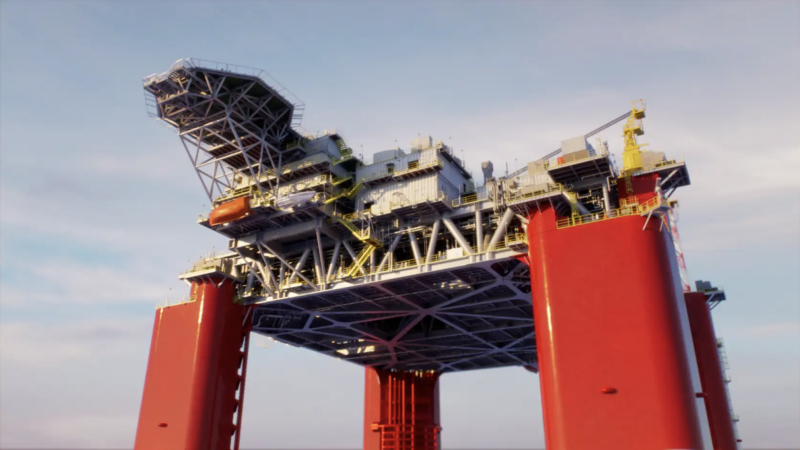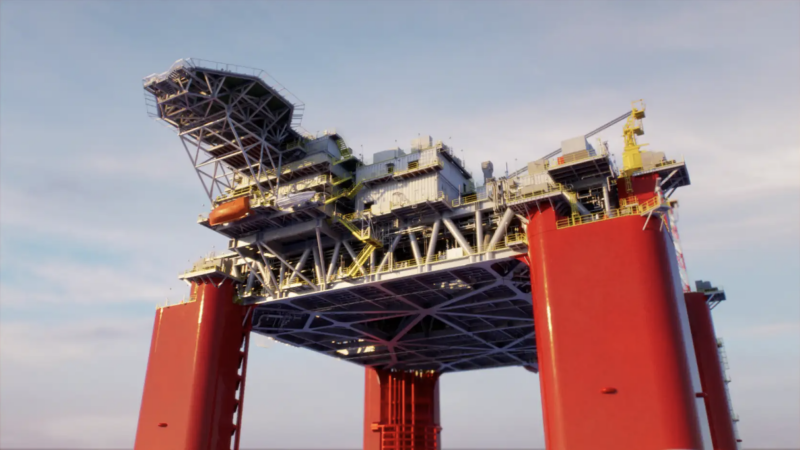September 29, 2025
 The Tiber floating production platform is expected to start production in 2030. BP rendering.
The Tiber floating production platform is expected to start production in 2030. BP rendering. Supermajor BP plc, London, has made a final investment decision on the $5 billion Tiber-Guadalupe oil and gas project in the U.S. Gulf, marking its second new production platform approved in the region in under two years.
Supermajor BP plc, London, on Monday announced it has made a final investment decision on the $5 billion Tiber-Guadalupe oil and gas project in the U.S. Gulf of Mexico, marking its second new production platform approved in the region in under two years.
The Tiber-Guadalupe project, fully owned and operated by BP, will become the company’s seventh operated production hub in the Gulf of Mexico, referred to by the U.S. government as the Gulf of America. It includes a new floating production platform designed to produce up to 80,000 barrels of crude oil per day. The development comprises six wells in the Tiber field and a two-well tieback from the Guadalupe field. First production is targeted for 2030.
“Our decision to move forward on the Tiber-Guadalupe project is a testament to our commitment to continue investing in the Gulf of America and expand our energy production from one of the premier basins in the world,” said Andy Krieger, BP’s senior vice president, Gulf of America and Canada. “Along with its sister project Kaskida, Tiber-Guadalupe will play a critical role in BP’s focus on delivering secure and reliable energy the world needs today and tomorrow.”
The Tiber and Guadalupe fields, located in the Keathley Canyon about 300 miles southwest of New Orleans, are estimated to hold approximately 350 million barrels of oil equivalent in recoverable resources during the project’s initial phase. Additional development phases may follow pending further evaluation.
The Tiber-Guadalupe project is among 8–10 major global projects expected to start between 2028 and 2030 and is part of the company’s broader strategy to grow its upstream business and long-term shareholder returns, BP said. BP expects to invest around $10 billion in its Paleogene projects in the U.S. Gulf, including Tiber-Guadalupe and the 100%-owned Kaskida development, which is scheduled to begin production in 2029.
Combined with the company’s five existing platforms in the region, the Tiber-Guadalupe and Kaskida projects will help BP reach a production capacity of over 400,000 barrels of oil equivalent per day from the U.S. offshore by 2030, the company said, noting that it aims to exceed 1 million barrels of oil equivalent per day in total U.S. production — both onshore and offshore — by the end of the decade.
The company is leveraging more than 85% of the Kaskida design to streamline construction and reduce costs for Tiber-Guadalupe. Development costs for the Tiber project are expected to be about $3 per barrel lower than Kaskida.
“Tiber-Guadalupe represents a significant step forward in our efforts to unlock the potential of the Paleogene in the Gulf of America, building on our decades of experience in the region,” said Gordon Birrell, BP’s executive vice president of production and operations. “Together with our Kaskida project in the Paleogene, we expect Tiber-Guadalupe will be another world-class development.”
The project will be BP’s second in the Gulf of America to utilize 20,000-psi (20K) pressure management technology. The company has worked with the offshore industry to develop and validate 20K equipment — such as high-pressure drilling rigs and subsea components — since discovering the Tiber field in 2009.
As of 2024, BP produced approximately 341,000 barrels of oil equivalent per day from the Gulf of America. The company currently operates five platforms in the region — Argos, Atlantis, Mad Dog, Na Kika, and Thunder Horse — and holds interests in four additional non-operated hubs: Great White, Mars, Olympus, and Ursa.
BP is also advancing several other Gulf projects, including the recently launched Argos Southwest Extension and planned expansions at the Atlantis platform. These projects are expected to account for nearly one-third of BP’s 10 global major project startups scheduled through 2027.

